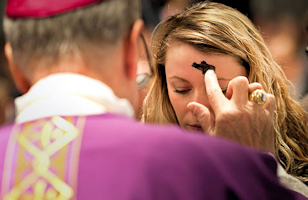Ordinary Time: February 13th
Tuesday of the Sixth Week of Ordinary Time
Other Titles: Mardi Gras; Plentone; Carnival; Fastelaven; Collup Monday; Carnevale; Shrove Tuesday; Fat Tuesday
Free eBook:

|
| Free eBook: Liturgical Year 2023-2024, Vol. 4 |
» Enjoy our Liturgical Seasons series of e-books!
Today the Roman Martyrology commemorates Bl. Christine of Spoleto (1435-1458). Born Agostina Camozzi in Osteno, Como, Italy, she was the daughter of a well-known doctor. After several years of living contrary to God's ways, she gave herself to Jesus, became an Augustinian Tertiary, and gained a reputation as a holy woman and miracle worker.
February 7-14 marks the National Marriage Week.
It is also the day before Ash Wednesday, called Mardi Gras or Fat Tuesday. Traditionally, it is the last day for Christians to indulge before the sober weeks of fasting that come with Lent. Formally known as Shrove Tuesday, Mardi Gras has long been a time of extravagant fun for European Christians. In many southern states of the USA Mardi Gras is a traditional holiday. The most famous celebration takes place in New Orleans, Louisiana. It has been celebrated there on a grand scale, with masked balls and colorful parades, since French settlers arrived in the early 1700s.
Please see Recipes, Activities, Prayers and Documents for Tuesday Before Ash Wednesday
 Today is a traditional feast honoring the Holy Face of Jesus. On April 17th, 1958, His Holiness Pope Pius XII confirmed the Feast of the Holy Face of Jesus as a movable feast on Shrove Tuesday (Tuesday before Ash Wednesday) for all the dioceses and religious orders who would ask for the Indult from Rome. Devotion to the Holy Face was revealed by Jesus to Sr. Marie of St. Peter (1816-1848) a Carmelite nun of Tours in France. The primary purpose of the devotion is to make reparation for sins against the first three commandments. Learn more about this devotion at Holy Face Devotion, the Holy Face Association and this article for more information.
Today is a traditional feast honoring the Holy Face of Jesus. On April 17th, 1958, His Holiness Pope Pius XII confirmed the Feast of the Holy Face of Jesus as a movable feast on Shrove Tuesday (Tuesday before Ash Wednesday) for all the dioceses and religious orders who would ask for the Indult from Rome. Devotion to the Holy Face was revealed by Jesus to Sr. Marie of St. Peter (1816-1848) a Carmelite nun of Tours in France. The primary purpose of the devotion is to make reparation for sins against the first three commandments. Learn more about this devotion at Holy Face Devotion, the Holy Face Association and this article for more information.
Shrove Tuesday
The day before Ash Wednesday is a celebration marking the start of the penitential season of Lent. Before Lent — a time of prayer, fasting and penance through a period of 40 days until Easter — Catholics and others celebrate with festivities known by several names.
In the United States, it’s most commonly known as Mardi Gras, French for Fat Tuesday. The tradition includes consuming foods containing animal fat before the beginning of Lent. Catholics enjoy a day of festivities, sometimes hosting their own carnivals or parties. The largest Mardi Gras celebration in the United States takes place in New Orleans. The celebration is known as Carnival in other parts of the world.
Catholics also prepare for Lent by spiritually removing themselves of sin through the Sacrament of Reconciliation. That is why this day is also referred to as Shrove Tuesday, from the old English word shrive, meaning to confess all sins.
Some countries, including England and Ireland, celebrate Pancake Day by consuming what else — pancakes. For centuries, it’s been a tradition to eat pancakes or other foods made with butter, eggs and fat, which would be given up during Lent.
No matter what it’s called, the day before Lent is a reminder of the sacrifice that is to come in the next 40 days. We also are reminded of the sacrifices Jesus made as he fasted and prayed for 40 days after his Baptism and before the beginning of his ministry.
Catholics are called to fast, pray and confess sins during this penitential season. For more ideas on making a good Lent, see Recipes and Activities for Mardi Gras.
—Excepted from the Archdiocese of St. Louis
 Meditation: Preparing for Lent
Meditation: Preparing for Lent
No Lent is worthy of the name without a personal effort of self-reformation, of leading a life more in accordance with God's commands and an attempt by some kind of voluntary self-denial to make reparation for past negligence. But the Church, together with the personal effort which she requires of all of us, her children, sets up in the sight of God the cross of Christ, the Lamb of God who took upon Himself the sins of man and who is the price of our redemption. As Holy Week approaches the thought of the passion becomes increasingly predominant until it occupies our whole attention, but from the very beginning of Lent it is present, for it is in union with the sufferings of Christ that the whole army of Christians begins on the holy "forty days", setting out for Easter with the glad certitude of sharing in His resurrection.
"Behold, now is the acceptable time, behold, now is the day of salvation." The Church puts Lent before us in the very same terms that formerly she put it before the catechumens and public penitents who were preparing for the Easter graces of baptism and sacramental reconciliation. For us, as it was for them, Lent should be a long retreat, one in which under the guidance of the Church we are led to the practice of a more perfect Christian life. She shows us the example of Christ and by fasting and penance associates us with his sufferings that we may have a share in His redemption.
We should remember that Lent is not an isolated personal affair of our own. The Church avails herself of the whole of the mystery of redemption. We belong to an immense concourse, a great body in which we are united to the whole of humanity which has been redeemed by Christ. The liturgy of this season does not fail to remind us of it.
This, then, is the meaning of Lent for us: a season of deepening spirituality in union with the whole Church which thus prepares to celebrate the Paschal mystery. Each year, following Christ its Head, the whole Christian people takes up with renewed effort its struggle against evil, against Satan and the sinful man that each one of us bears within himself, in order at Easter to draw new life from the very springs of divine life and to continue its progress towards heaven.
—Excerpted from The Saint Andrew Daily Missal
Highlights and Things to Do
- Today is Fat Tuesday, or Mardi Gras! Try some of the traditional recipes linked here. When eggs were among the foods that were forbidden by the Church during Lent, people would use them up on Fat Tuesday by mixing up large quantities of pancakes or doughnuts (also known as fastnachts).
- Read Maria von Trapp's explanation of the traditions associated with Carnival, or Fat Tuesday here.
- Sing this American favorite, Turkey in the Straw, with your children as part of your Mardi Gras celebrations.
- Discuss Jesus' Gospel teaching for today, He who would be first must be last, with your children and ask them how they can put others in the family before themselves. Keep it simple and practical — setting the table, washing the dishes, folding laundry, watching the littler ones, doing homework right away.
- What does it mean to become a child spiritually, that we may enter Heaven and be received by Christ Himself? We can learn much from St. Therese of the Child Jesus about spiritual childhood. Begin reading her autobiography, Story of a Soul. ICS Publications with John Clark, OCD's critical edition is considered the best.
- Read Fr. William Saunder's article, Shrove Tuesday and Shrovetide, from the Catholic Culture Library.
- Read Jennifer Gregory Miller's two part explanation on Carnival: Carnival Part One: A Season of Contrasts and Carnival: Part Two, the Final Countdown.
Bl. Christine of Spoleto
Blessed Christine suffered great losses early in life, causing her to reconsider seriously the goals and ambitions she had previously considered essential.
Trials brought her to a deeper level of faith in God, renewed dedication to the Church, and generous service to others. She found in Augustinian spirituality a reliable guide and support in living the Christian life, while remaining a laywoman fully engaged in the world
Agostina Camozzi was the daughter of a well-known doctor in Ostenso in the Italian province of Como. A graceful and attractive young woman, she married at an early age but within a short time was left widowed. In a second relationship she suffered the loss of her only child, a son. A subsequent marriage left her widowed again, this time at the hands of a jealous rival. In about 1450 Agostina underwent a serious conversion, became an Augustinian Tertiary, and changed her name to that of Christine.
Her life now was to be one of penance, prayer, and the works of mercy. She lived in various Augustinian convents, moving from one to another, in order to remain in obscurity as best she could. In 1457 she undertook a pilgrimage with the intention of visiting Assisi, Rome and Jerusalem. Together with another tertiary she arrived in Spoleto in the province of Perugia where she devoted herself to the care of the sick and where she died on February 13, 1458, not yet 30 years of age.
Her body was interred in the Church of Saint Nicholas in Spoleto, which at the time belonged to the Augustinians. Her reputation as a woman of holiness and a worker of numerous miracles caused devotion to Christine to spread quickly and widely. Gregory XVI confirmed her cult in 1834, proclaiming her blessed.
—Excerpted from the Augustinian Website
Patronage: Calvisano, Italy
Highlights and Things to Do:
- Read more about Bl. Christina:
- Bl. Christina's relics are located in church of Saint Gregory the Great in Spoleto, in the Umbrian region of Italy.
- There is an academic reading of the study of Blessed Christina's mummy. Her body was preserved artificially. See Idle Speculations for a short summary.







